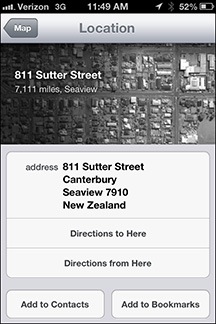This example was so outrageous, I had to share it.
I spent last weekend in California with friends. (Blog post to come, eventually.) On Friday, they needed to take care of business in the Folsom area. We decided to have lunch while we were out.
My friends are not smartphone people, although one of them does have an iPod Touch that she uses with various apps on WiFi. In an effort to show how useful a smartphone could be, I used Apple Maps and my preferred navigation app, MapQuest, to navigate to their primary destination. It worked like a charm.
 Afterwards, I used the Google Search app to perform a voice search (on my iPhone 4; no Siri) for “restaurants serving breakfast in Folsom California.” The app understood me perfectly and displayed a list of results. We decided on the Sutter Street Grill. The entry for the restaurant included its address as a link, as you can see in the screenshot. I tapped the link to view the location in Apple Maps.
Afterwards, I used the Google Search app to perform a voice search (on my iPhone 4; no Siri) for “restaurants serving breakfast in Folsom California.” The app understood me perfectly and displayed a list of results. We decided on the Sutter Street Grill. The entry for the restaurant included its address as a link, as you can see in the screenshot. I tapped the link to view the location in Apple Maps.
 And that’s where things got weird. It showed me the location on the map, but no matter how far I zoomed out, I could not see the dot representing our current location. And then I realized that the body of water on the map was a lot bigger than the lake we’d driven by.
And that’s where things got weird. It showed me the location on the map, but no matter how far I zoomed out, I could not see the dot representing our current location. And then I realized that the body of water on the map was a lot bigger than the lake we’d driven by.
 I tapped the arrow beside the location on the map. And that’s when I discovered that the map was showing us a location in New Zealand.
I tapped the arrow beside the location on the map. And that’s when I discovered that the map was showing us a location in New Zealand.
Here’s where I see a problem. I’m in California. The phone knows I’m in California. Yet when I tapped the address, it displayed a location on the other side of the planet.
And no, the location wasn’t incorrect in the link — although the street name does not include the word “historic.” For some reason that I can’t understand, Apple Maps decided to display 811 Sutter Street in Canterbury Seaview, New Zealand, 7,111 miles away, instead of the 811 Sutter Street that was less than 5 miles away.
Come on, Apple. Firing people isn’t going to fix the problem. Let’s get down to business and make this app work right.
By the way…the restaurant was great!
